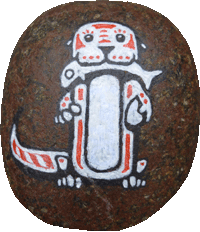4th May 2011
Three remarkable things, that makes this a remarkable day. I shall elaborate…
This morning we visited the Remarkable Rocks, which perch on the cliffs above the Southern Ocean on the south coast of the island. And they truly are remarkable. It looks like a modern artist has created a huge abstract installation in the bush. Or as though giant rock-devouring caterpillars have been munching away at the granite blocks for millenia. It’s very hard to capture on camera, so you’ll just have to go there yourselves. Remarkable.
Then as we left Flinders Chase NP we passed a sign warning us to beware of geese on the road. And quite right, as around the corner there were two geese on the road. Not remarkable in itself, but as we slowly approached (expecting them to move off) one of the geese simply sat down in the road right in front of us. We had to stop. Then the other goose climbed on top and… ahem… sat on the other goose. Job done, they both waddled off and let us go. I have never seen such a blatantly exhibitionist display in all my life. Remarkable.
Our third remarkable thing is the echidna. These spiny little mammals are the most widely distributed wild mammal in all of Australia, found in all parts of all states, but they wander at random and so are hard to find. Kangaroo Island is one of the best spots, and this afternoon we got lucky with not one but five different echidna along just ten kilometers of road. So what is so remarkable about the echidna?
Well, take a look at it. Instead of fur it is covered in spines. These are for defense, when it feels threatened it can curl up into a ball and present a prickly barrier to any attacker. It has a long snout looking like a drinking straw which it uses for nosing into ant and termite nests once it has dug them open with its big paws. Sensors in its snout can actually detect the electric impulses from the muscles in an insect’s legs! Termites are more numerous than ants, but in dry seasons echidna seem to prefer ants because they have a higher water content. Once it has found them it licks up its meal with an 18cm long tongue and slurps them down, as it has no teeth.
The echidna is a monotreme, which means it lays eggs like a bird. In fact a female echidna only lays one egg at a time, and she has a pouch which the egg is kept in until it hatches. Then the baby echidna remains in the pouch just like a kangaroo or koala. The mother only puts up with this until the baby grows spines, after which he has to live in a burrow! Echidna milk is pink. The monotremes are a very ancient group of mammals which only have two surviving members – the echidna and the platypus. But despite being so ancient, it’s clearly one of the most successful mammals in Australia. Spiky egg-laying ant-eating echidna. Remarkable.
Let’s take a closer look at the echidna in action (make sure you have sound turned on)…
Related Images:















































Learned at the Smithsonian Natural History Museum that there are only 3 VENOMOUS mammals in the world. Two are Australian monotremes mentioned on this page, to wit: the echidna & the duck-billed platypus. They have a spur at the ankles of their back legs which delivers the venom. The third venomous mammal is a native of most of North America: the short-tailed shrew, which has a neuro-toxin in it’s saliva. There you have it.
Interestingly, the reference I have here says that the echidna has the spur on its leg but doesn’t have venom in it. The platypus certainly does, but it is only the male and it is actually only venomous during the breeding season. Researchers have no idea why this should be.
I really only know what I memorized from the exhibit that long-ago day at the Smithsonian Natural History Museum…. I suppose I could be wrong… 😉
Monotremes are just WEIRD animals!
I want to try echidna milk!
That’s going to be some fiddly and thorny expressing. Are you sure you wouldn’t prefer a strawberry milkshake?
Expressing… have I got the right word there? 🙂
You do have the correct word.